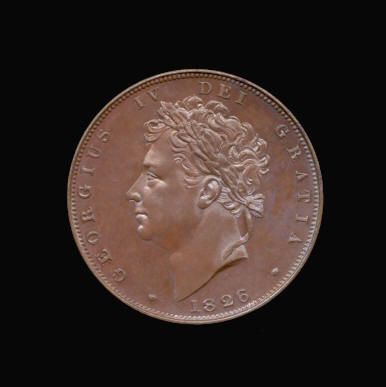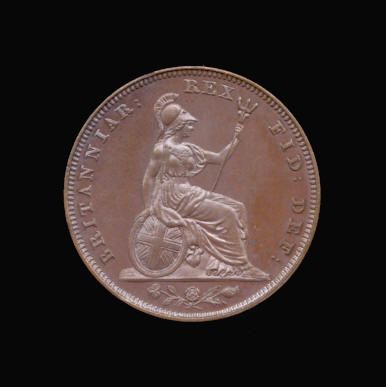

Farthing
This coin is surrounded by a raised edge, within which is a dotted circle, and this, with variations, has occurred on
all subsequent copper coins. The following dates occur: 1821, 1822, 1823, 1825, and 1826. The last date is rare and
curious, as it occurs after Wyon's coinage had been issued. There is a very rare (perhaps unique) copper proof of
1821 and others of the date 1822.
There is also a "mule" in platinum (R. 8) with the reverse of the farthing of this coinage but with the obverse of
the Bank Token for ninepence of 1812.
In 1825 the king objected very strongly to the continuance of Pistrucci's portrait, and requested that artist to design
a fresh model from the picture then recently painted by Sir Thomas Lawrence. This Pistrucci very reasonably refused
to do, for the portrait by Lawrence was a full-faced one, and could be of very little use in obtaining a likeness in
profile. The king then proposed that Chantrey, whose bust had given him great satisfaction, should execute a medallion
from it, and that Pistrucci should re-model his coins by this; but the latter declined to copy the work of any other
artist, and as the king refused to sit again, the work was committed to Mr. William Wyon. The series in copper
consisted of the penny, halfpenny, farthing, half-farthing, and third-farthing. The half-farthing, which is of the
dates 1828 and 1830, was for the use of Ceylon, and the third-farthing, which occurs of the date 1827 only, for that
of Malta.
Penny
The dates 1825, 1826, and 1827 occur. Copper proofs of 1825 and 1826, also occur. The latter with the halfpenny
and farthing of the same date, form part of the Mint set.
Halfpenny
The dates are 1825, 1826 and 1827. Copper proofs of 1825 and 1826, and bronze proofs of 1826 and 1827 occur.
Farthing
The dates are 1826, 1827, 1828, 1829 and 1830. Copper and bronze proofs occur of 1826.
In the cabinet of Mr. R. A. Hoblyn and in the Imperial Cabinet at Vienna (the former from the Bergne and Cuff collections)
is a coin which as the obverse of the Irish penny of this sovereign and the reverse of the Ionian Islands piece
(penny size) by Wyon. This has been considered as a pattern piece, but must be treated as a mere "mule," particularly as it,
of necessity, bears no date.
The Copper, Tin, and Broze Coinage of England
H Montagu, F.S.A, , 1893
George IV
George IV, 1820-1830
The first copper coinage of this monarch consisted of farthings only. They are the work of Pistrucci,
and the whole series, of which they formed part, was distasteful to the king. They represent the face
as puffed and bloated, the neck undoubtedly thick, and the hair harsh and wiry.
1. O. GEORGIUS IIII DEI GRATIA. The head as described above, looking to the left, laureate and draped in a mantle,
clasped on the shoulder by a brooch.
R. BRITANNIAR : REX FID : DEF : Britannia seated to the right, helmeted, an olive branch in her right hand;
a trident in her left; at her feet, a lion. Date in exergue.
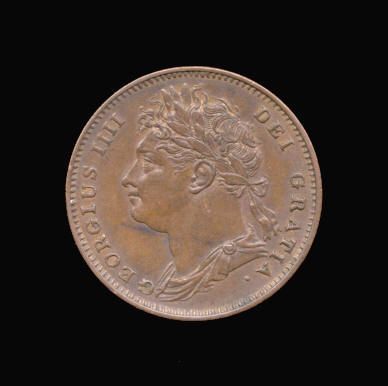
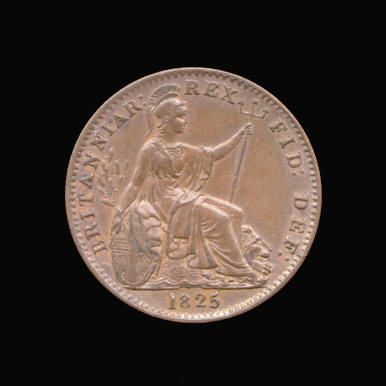
2. O. GEORGIUS IV DEI GRATIA. The bust of the king, laureate, looking to the left. No drapery.
Under the head, the date between two small ornamental mint marks.
R. BRITANNIAR : REX FID : DEF : Britannia as before, but without the olive branch and lion;
the right arm resting on the shield. In the exergue the rose, thistle, and shamrock intertwined.
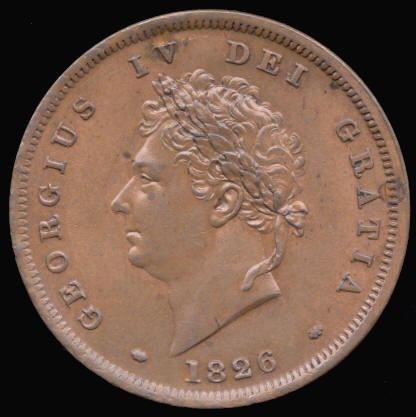
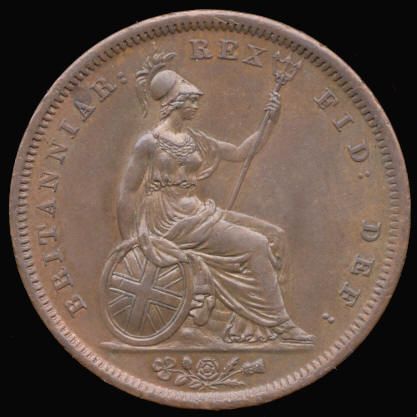
3. O. As the penny, except that the two small mint marks are plain and not ornamented.
R. As the penny.
4. O. As the penny.
R. As the penny.
